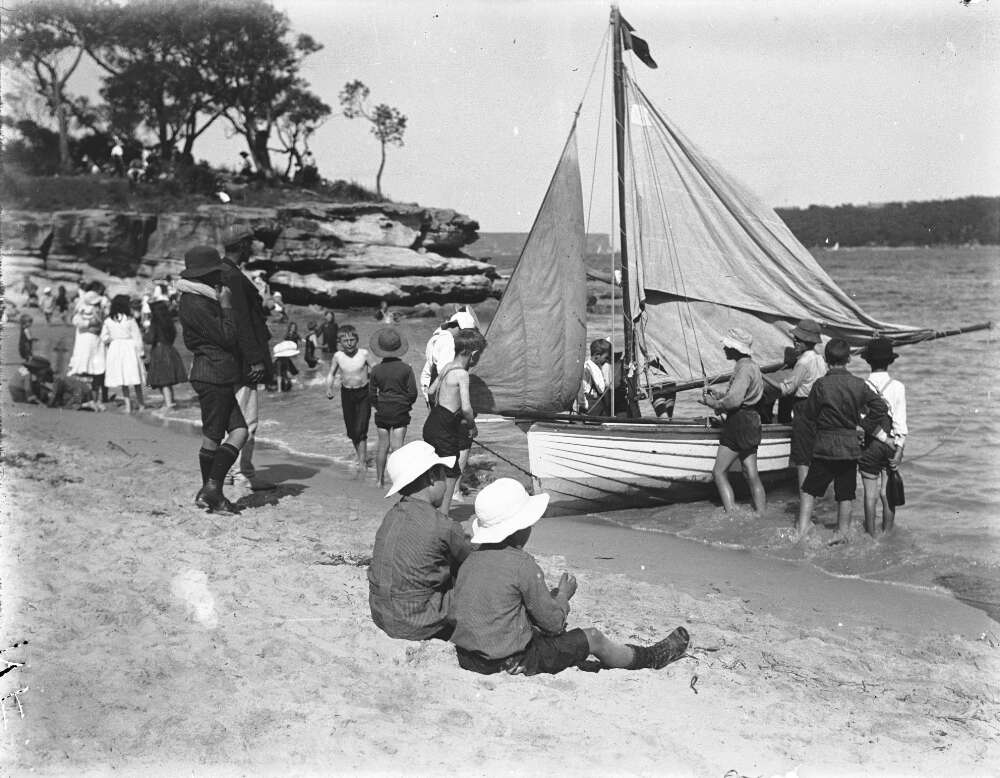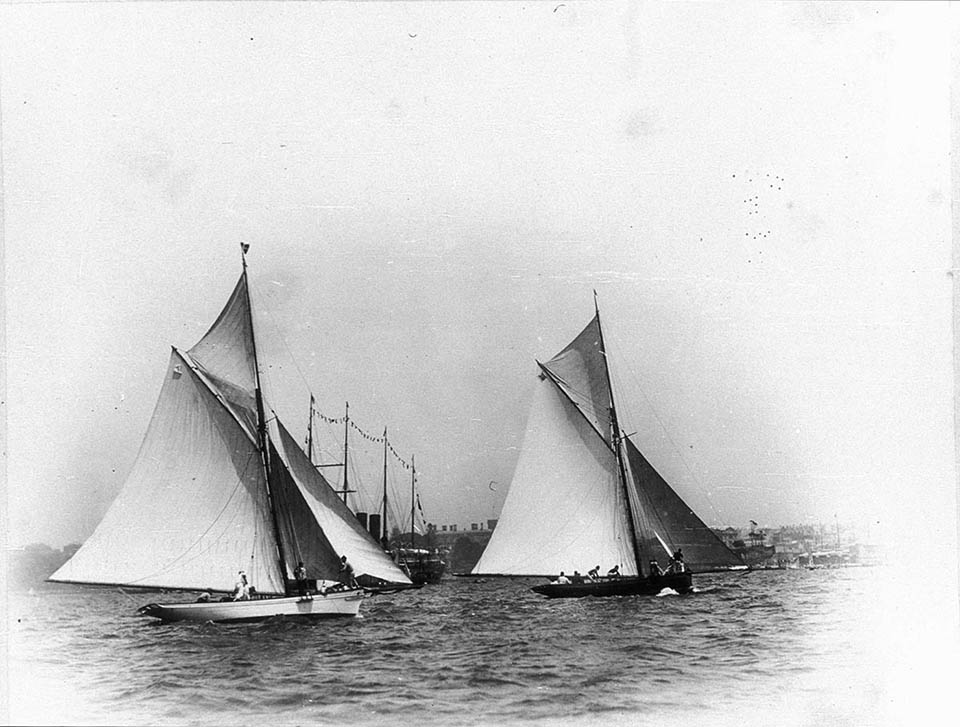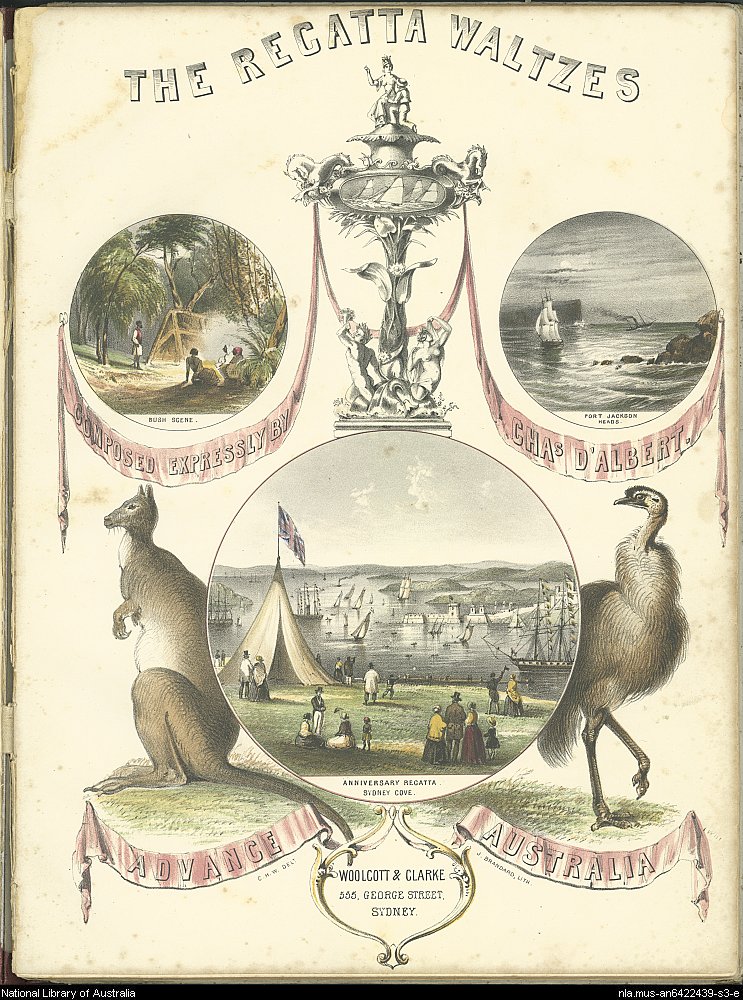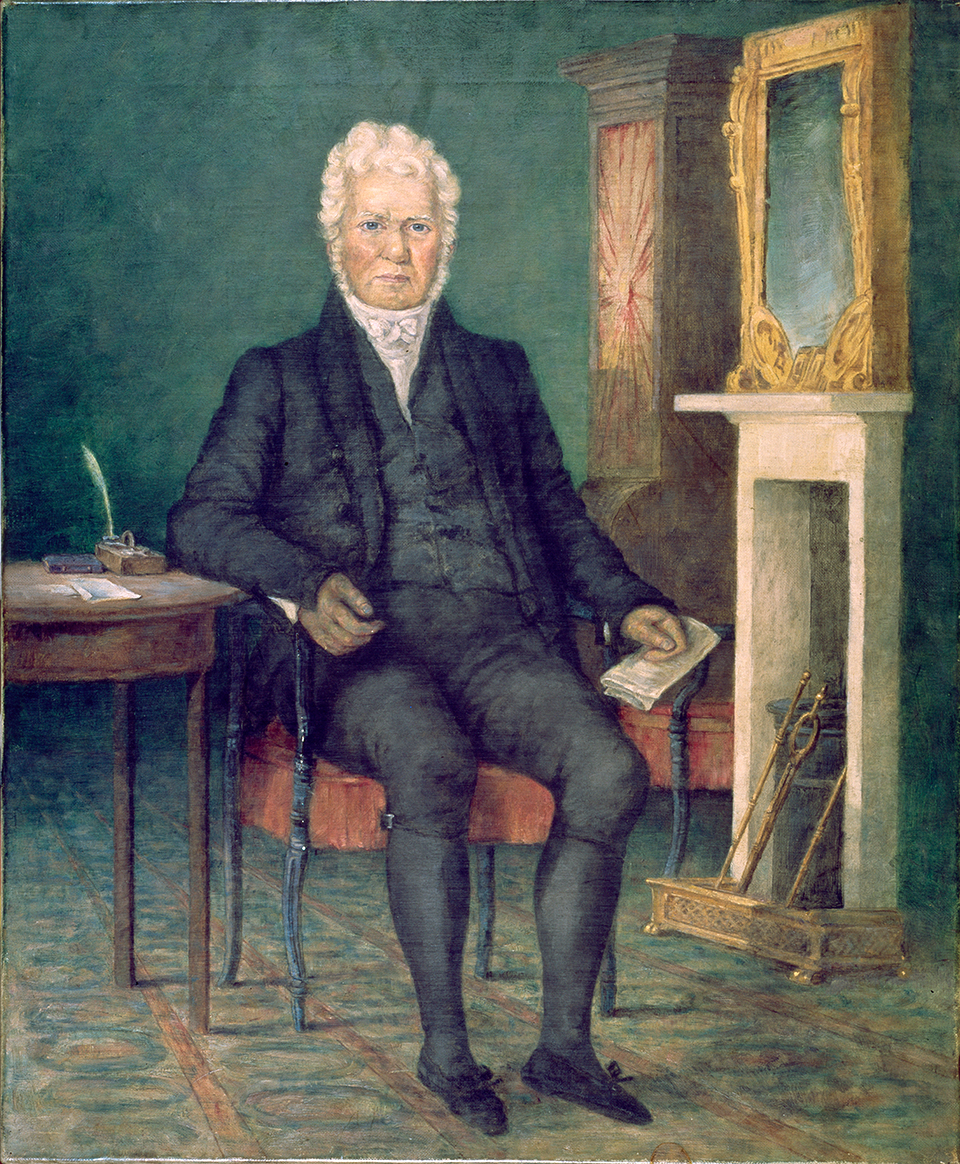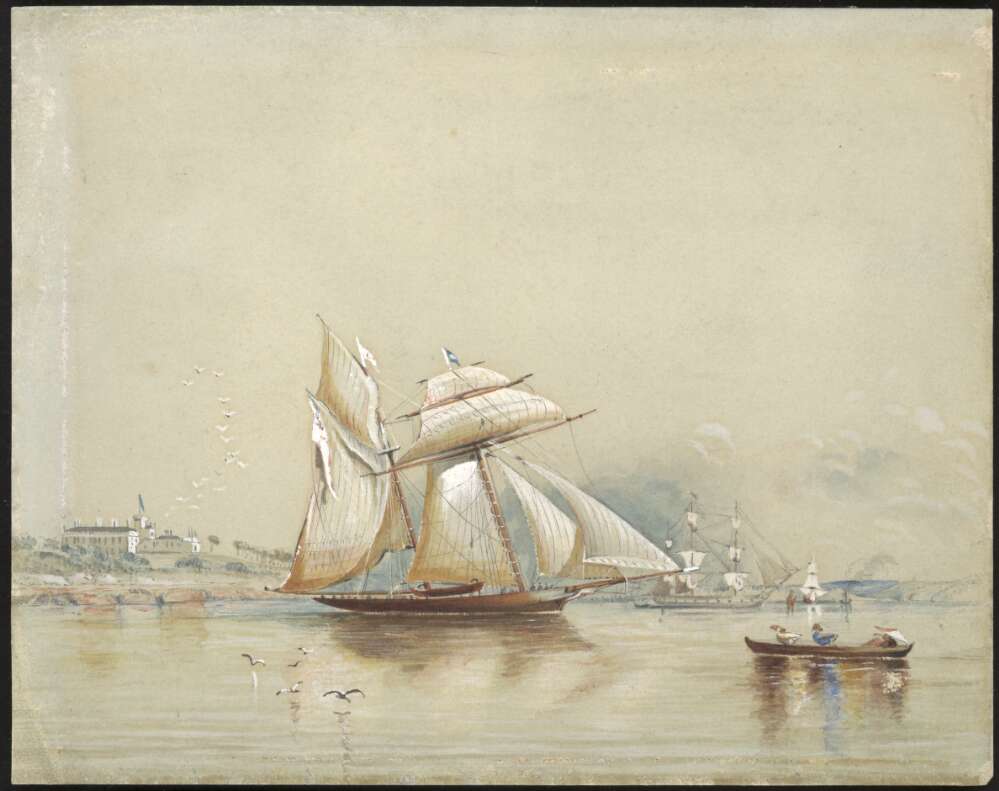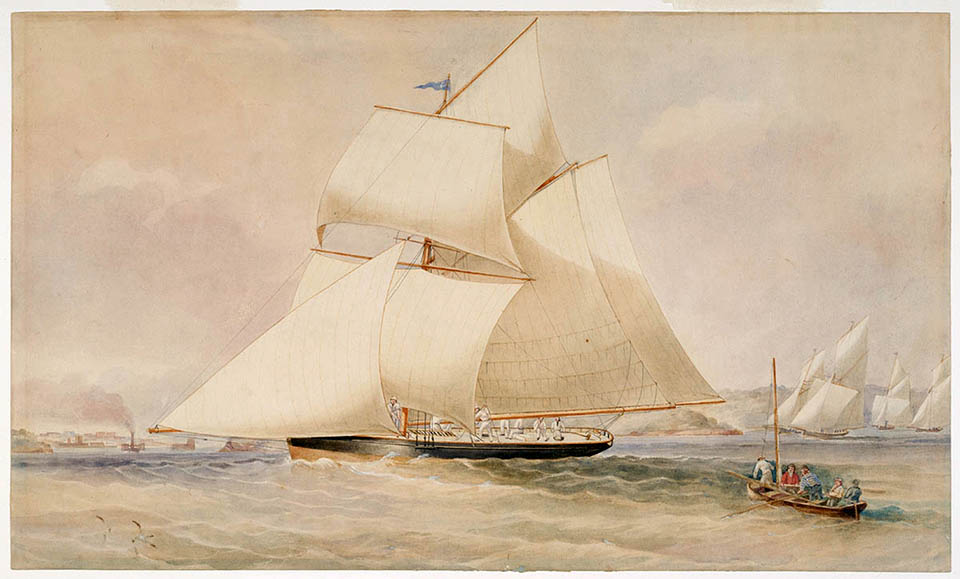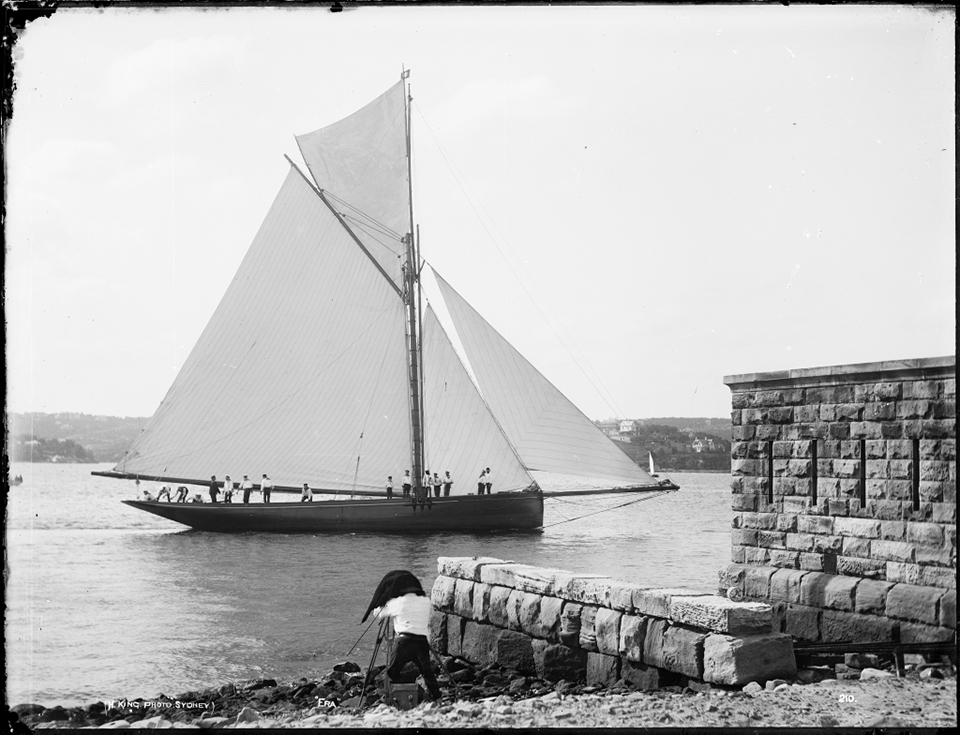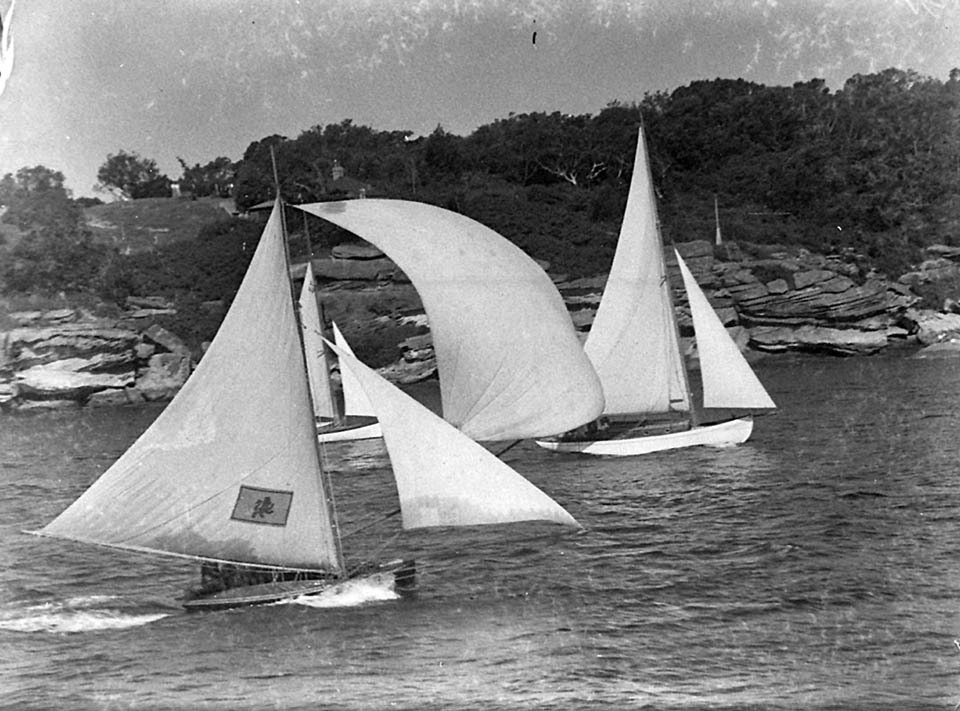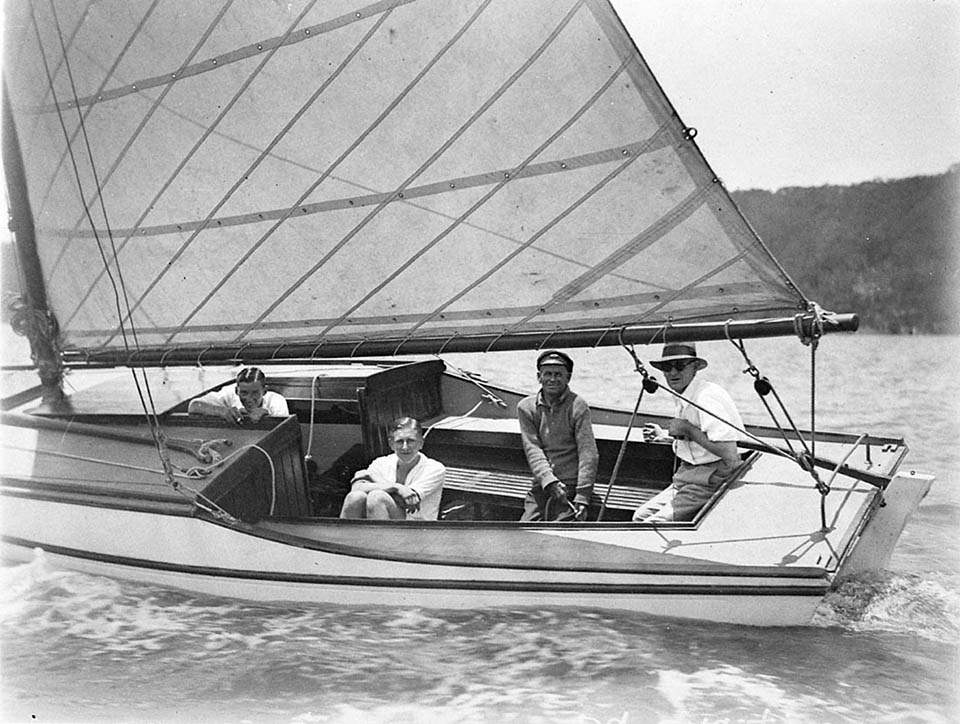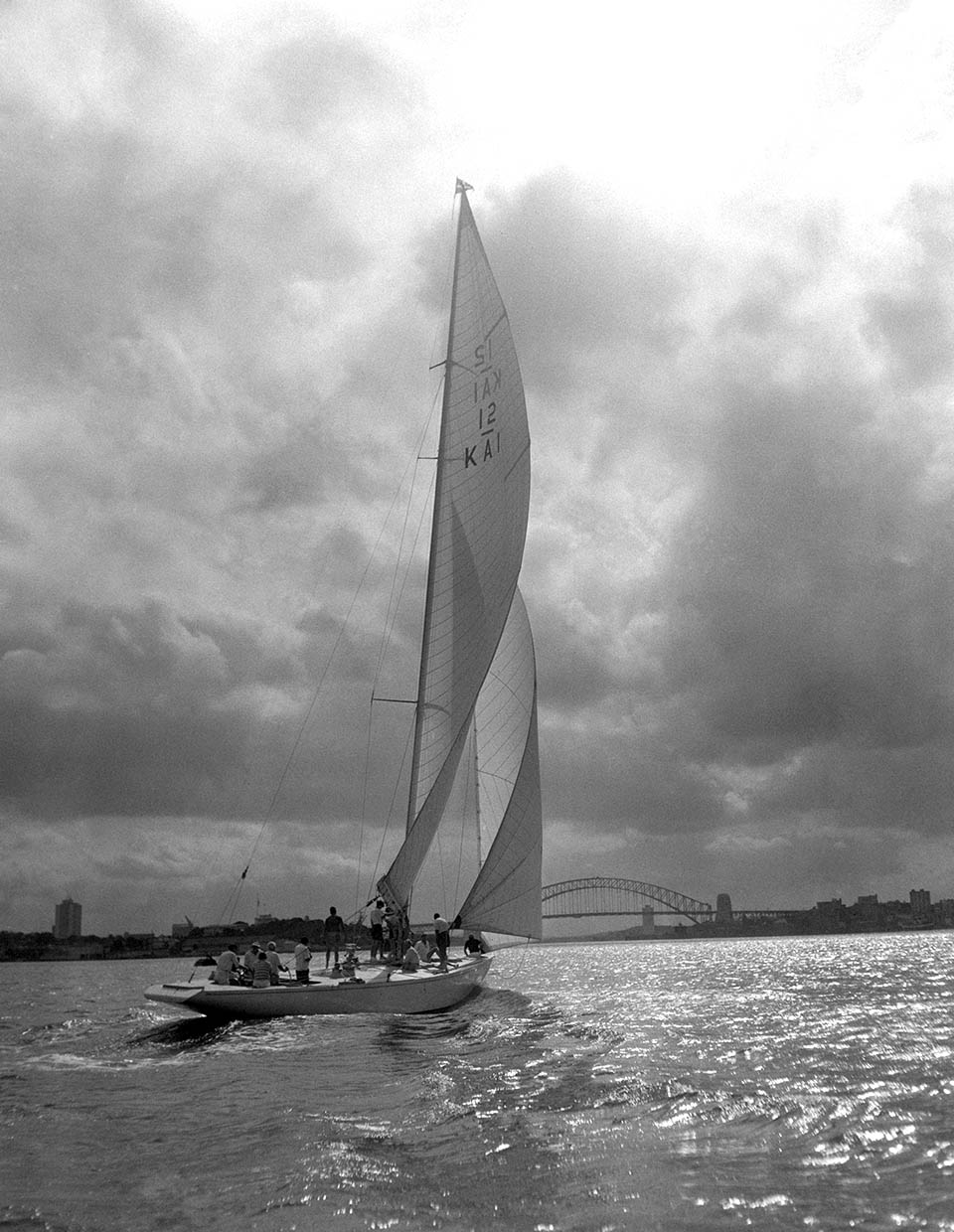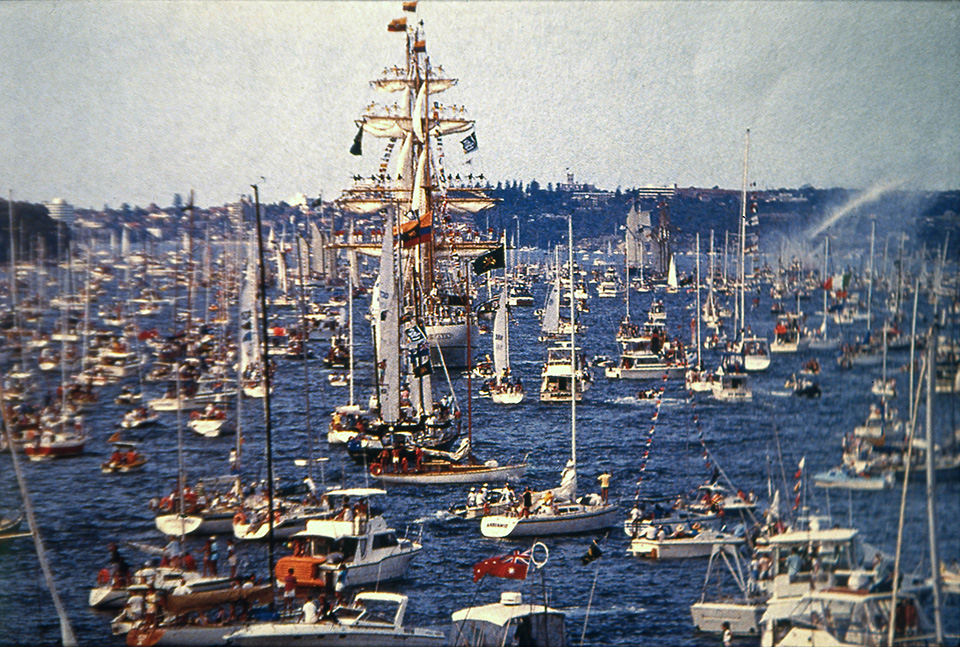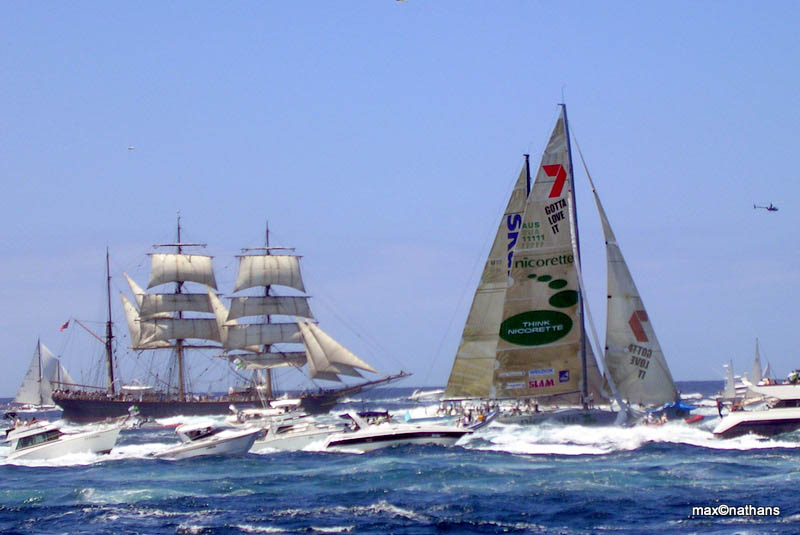The Dictionary of Sydney was archived in 2021.
Sailing
Citation
Persistent URL for this entry
To cite this entry in text
To cite this entry in a Wikipedia footnote citation
To cite this entry as a Wikipedia External link
Sailing
[media]Recreational sailing was a product of Sydney's function as a seaport town. The first European colonists clung to the coastline and looked to the harbour and the sea for survival. Sailing has since adapted to both reflect and contribute to Sydney's changing culture and customs. Sailing in Sydney has been multifaceted. Instead of presenting a single homogenous sailing culture, a number of cultures and identities have coexisted on Sydney Harbour and its surrounding waterways. Recreational sailing includes a broad spectrum of activities, from sailing small dinghies in sheltered waters to long-distance ocean races and cruises sailed out of and into Sydney Harbour. This essay traces the broad and overlapping developments of Sydney's recreational sailing cultures.
Racing
The origins of recreational sailing on Sydney Harbour differed from the traditions of yachting in England as practiced by the ruling classes. Early nineteenth-century sailing races were an extension of working maritime practices, reflecting Sydney's focus towards the harbour and the sea. Captains of visiting naval and merchant ships were known to organise challenge matches between their crews. [1] These were raced in the skiffs, gigs, and whaleboats that large ships carried on their decks. Some ships carried a modified racing boat specifically for such matches. The races provided sport for the ship's captains in the form of gambling, and training for their crews while in port. [2]
Sydney's first regattas were similar to the early challenge matches. In 1827, Captain Rous and Captain Stirling organised a series of rowing and sailing matches on the harbour. The officers of His Majesty's ships Success [media]and Rainbow donated a purse of 50 Spanish dollars as a prize for the sailing race, which was won by Lieutenant Preston's Black Swan. The regatta was a public event. Spectators of 'all ranks and denominations' crowded Dawes Point and Macquarie's Fort and the colony's elite watched the day's events from the decks of the Success and Rainbow. The Sydney Gazette reported that the regatta was 'attended with emulation' and 'abstracted from the semblance of cruelty'. [3]
Regattas [media]developed as an appropriate way of celebrating public holidays and the progress of Sydney. 'Anniversary regattas' were held as early as 1828 and annually from 1837 to celebrate the foundation of the colony. [4] Like the 1827 regatta, these were also popular public events. Crowds of spectators would line the foreshores and take to the harbour in all manner of craft. Regattas contrasted to traditional violent and rowdy leisure, such as gambling, drinking and blood sports. In 1838, the Sydney Morning Herald reported that at the Anniversary Regatta: 'There has not been as much drunkenness as we have been in the habit of seeing'. [5] Sailing races were identified as a legitimate pastime and one of the first 'national' sports of the colony. [6]
Yachting
Yachting was a more private activity than boat racing. Yachts are generally defined as private pleasure boats. Sydney [media]merchant Robert Campbell is considered to have owned and built Sydney's first private pleasure boat, an open boat with a sliding gunter rig used for cruising on the harbour. [7] As Sydney shifted from a penal colony to a trading city, the number of pleasure boats owned and sailed by wealthier citizens increased. Regattas began to be contested by locally built private sailing boats. However, these small boats were not defined by contemporaries as 'yachts'. The English practice of yachting was traditionally the pastime of the Royal Court and aristocracy. Yachts belonging to the prestigious Royal Yacht Squadron in Cowes, established in 1815, maintained a semi-naval status due to their royal connections. [8] English yachting provided a standard of prestige and respectability that yacht sailors in Sydney would aspire to.
Sydneysiders saw the first 'yacht' in the traditional sense of the word [media]when Wanderer , belonging to entrepreneur Benjamin Boyd, sailed into the harbour in October 1842. The yacht flew the white ensign of the Royal Navy, signifying membership with the Royal Yacht Squadron, and carried 13 guns, which protected a large amount of capital for investment in the colony. The Wanderer's low black hull and shining brass work were features associated with the most luxurious British yachts at the time. [9] After the highly publicised arrival of the Wanderer, races that had previously been described as 'boat races' were now beginning to be described as 'yacht races' in the Sydney newspapers.
A variety of local and international events further influenced yachting in Sydney. The gold rushes and subsequent population growth, beginning in 1851, signalled the start of Sydney's transformation into a modern urban city. [10] In the same year, an American yacht (also named America) crossed the Atlantic and defeated the fleet of the Royal Yacht Squadron in a race around Cowes, inaugurating the America's Cup. [11] The event had been reported in the Sydney press, and with Sydney's new wealth, local sailors began to import both English and American yachts. The America's Cup had also sparked a fascination with yacht design and 'national types'. An amateur yachtsman, Richard Harnett, began to experiment with yacht design in Sydney. Harnett departed from the conventions of yacht design, and built a successful racing yacht that he named Australian . [12]
Yachting became established and organised in Sydney as a direct import of the pastimes of the English elite. In 1862, the Royal Sydney Yacht Squadron was established in the image of the Royal Yacht Squadron in England. The Sydney organisation was the first yacht club outside the British Isles to be granted permission to fly the prestigious blue ensign of the Royal Navy. [13] The pseudo-naval ceremonies and displays associated with English yachting were replicated on Sydney Harbour. On the opening day of the Royal Sydney Yacht Squadron, yachts sailed in formation under the orders of the commodore. They anchored in two 'squadrons' at Watsons Bay, before returning home, saluting and cheering the flagship. [14] The Squadron remains as Sydney's oldest and most prestigious yacht club.
[media]In 1863, Sydney yachtsmen had the opportunity to test the 'Australian type'. Wealthy businessman William Walker had imported the Chance, a large 80-ton English Schooner yacht. The Chance represented the English type. It belonged to the Royal Thames Yacht Club in England, and was the first flagship of the Royal Sydney Yacht Squadron. [15] Xarifa, a refined version of Australian, challenged and defeated Chance in a sailing race from Sydney Harbour to Long Reef and back in 1863. Like the America's victory in Cowes, Xarifa's win was remembered as the success of the colonial-built craft. [16] Yachts built and designed in Sydney were considered with pride as equal to those built in [media]the 'Mother Country'.
Open boats
Whilst Sydney yachts were defined by international standards as American, English and Australian, open boats became identified as the 'great Sydney type'. [17] Captain Joshua Slocum, a visitor to Sydney in the 1890s, described the typical Sydney boat as 'a handy sloop of great beam and enormous sail carrying power'. [18] Sydney's open boats were described as having a greater proportionate sail area than any type of boat in the world. [19] A guide to Sydney Harbour described these boats:
The main idea is to crowd as much sail on to the boat and as many men into her as wood and canvas allow. The type is the same in the eight-footer and the twenty-four: broad, powerful, shallow, with colossal sail and centreboard. [20]
[media]The open boats that were being sailed by the end of the nineteenth century had developed from the working boats of Sydney Harbour, ship's boats, fishing boats and waterman's skiffs. The wide shallow hulls and large centreboards were further influenced by American designs from the 1850s. Without a keel to prevent them from capsizing, open boats required a large crew to act as 'live ballast'. What was especially unique to Sydney was the popular culture that developed around the open boats from the 1890s to the 1930s.
[media]A number of factors contributed to the popularity of open boat sailing. First was the carnival atmosphere and popular following of regattas that had been maintained in Sydney since the 1830s. The racing of open boats had continued alongside the development of yacht racing. Second was the spectacle and danger associated with the open boats. Capsizes and mishaps were reported in detail alongside accounts of the exciting and [media]thrilling speed of the open boats. Third were Sydney's harbourside working-class suburbs where they were most popular. Sailing clubs for open boats were established in the suburbs of Balmain and Pyrmont. The boats were relatively inexpensive. During the 1890s depression, open boats had been constructed out of canvas when the cost of wooden planking had become prohibitive. Finally, a strong gambling tradition helped to maintain a regular spectator base for open boat races in Sydney. Even races for small six-foot boats and two-foot model boats attracted betting.
The above influences combined to make open boat sailing a modern and professional spectator sport. The potential spectator base for sailing was recognised by businessman Mark Foy, who established the Sydney Flying Squadron in 1891. Foy's radical new open boat club altered the format of open boat racing. Races were held on a short triangular course with handicapped starts and boats were identified by colourful designs on their sails instead of the traditional numbers seen on yachts. [21] By the end of the 1930s, [media]open boat racing had become a mass spectator sport on Sydney Harbour. Thousands of spectators and punters followed the racing every week, many aboard steamers specially hired by the open boat clubs. [22] Racing was a professional sport for Sydney's best crews, who sometimes played rugby during the winter moths and raced open boats during the summer.
Foy's changes improved open boat racing for spectators, but were not supported by the conservative yachting community. The committee for the annual Anniversary Regatta, then called the National Regatta, attempted to prohibit the use of coloured sails or designs in the 1892 event. A breakaway regatta organised by Foy held races for the 'coloured-sails boats' on the same day and received significant participation. [23] The protest was successful, and the open boats with coloured sails were allowed to participate in all subsequent regattas.
Open boats were excluded from yachting institutions as the activity became more organised in the nineteenth century. Before the Royal Sydney Yacht Squadron was established, there was little distinction between open boats or decked-in keelboats. The Royal Sydney Yacht Squadron, however, maintained the standards of the English Squadron, excluding all centreboard and open boats. This ruling excluded the American type of boat, as well as maintaining the elite character of the organisation. Other clubs such as the Sydney Amateur Sailing Club, and the Royal Prince Alfred Yacht Club catered for smaller yachts. By the 1890s, the semi-professional culture of open boat sailing was supported by gambling, and characterised by the image of danger, larrikinism and drinking. This was now incompatible with the middle-class and amateur culture of yachting.
Divisions between Sydney's working-class and middle-class sailors were revealed in the yachting press of the 1890s. A letter published in The Australian Yachtsman and Canoeist claimed that:
Nothing can be more ridiculous in my mind than our open boats here, with their enormous sails and unseaworthy qualities; they are always on the brink of capsize, and their owners seem to measure their sport by the nearness with which they can go to the inside of a shark. [24]
The perception of danger that made open boat sailing a popular spectator sport was now used as a criticism by the yachting community. The promoters of deep-keeled yachts claimed that open boats were unsuitable for Sydney conditions. The low sides, open decks, and large sail areas made coastal cruising and general sailing difficult. Critics of the open boat design looked away from Sydney for the ideal boat. American and English sailors in keelboats were considered the best amateur sailors in the world. Small keelboats designed for the Clyde were suggested as the best design for Sydney sailors.
Cruising
A broad spectrum of vessels cruised on and around Sydney Harbour. Enormous schooners from the Royal Yacht Squadron in Cowes visited Sydney as part of leisurely world cruises and small open boats were sailed on Sundays when not racing. Although yacht sailors had used the context of cruising to criticise the design of the open boats, the practice of cruising in Sydney was not exclusive. The Sydney Mail reported that all types of sailing boat, the 'decker', 'half-decker' and 'no-decker' (open boat), could be found in the cruising resorts to the north and south of Sydney Harbour. The cruising holiday had spread recreational sailing beyond the confines of closed waters. The popular 'cruising resorts' of Broken Bay and its surrounding waterways were roughly three hours sailing to the north of Sydney. A 'thousand of Cooks tourists could be hidden in Pittwater, Cowan and Brisbane Water with room remaining for yachting and boating men', the Sydney Mail claimed. [25]
Holidays [media]had been public experiences, with guesthouses and tourist hotels built around train stations and avenues of public transport. Not until after World War II would the car-based holiday reflect a broad privatisation of leisure. [26] Cruising was an earlier means of a private holiday for Sydney's boating population. Women and children were also more likely to be involved in cruising as a family activity than racing as a masculine sport. By the 1920s, cruising had become a sailing subculture. Romantic ideas of escape and private travel contributed to the characterisation of cruising sailors as bohemians and eccentrics. The establishment of a Sydney Cruising Club in 1937 was headlined with the subtitle 'A Bohemian Aquatic Organisation'. [27]
Postwar democratisation
Recreation became democratised in the wake of World War II. The suburbs became the focus of leisure, based on increasing car ownership, wages and free time. Sailing reflected these shifts. The suburban garage replaced the harbourside boatshed, as new technologies such as marine plywood and waterproof glues made amateur boatbuilding accessible to the masses. [28] Some new classes of sailing dinghy were designed specifically to fit on the roof of a car, linking new suburbs to sailing clubs. [29] From the 1950s, new sailing clubs were formed throughout Sydney Harbour, Pittwater, and Botany Bay. Sailing clubs became suburban family organisations, and both boys and girls were encouraged to sail. [media]Most of the new clubs supported 'class sailing', with a proliferation of new designs of dinghies and small sailboats. Some of these classes such as the 'Manly Junior' and 'Northbridge Senior' were associated with specific Sydney sailing clubs and locations. Other popular class dinghies, including the English 'Herron' and 'Mirror' dinghies, were imported designs, however most that were sailing in Sydney were home-built.
Ocean racing
The ocean became an increasingly popular place of recreation for Sydney's yacht sailors after 1945. [media]The Cruising Yacht Club of Australia had been established in Sydney in 1944. Ocean cruises and races were organised from its headquarters in Rushcutters Bay. Yachts used for ocean racing were very similar (and often the same) to those used for cruising in the first two decades after the war. As ocean racing became more competitive, ocean-racing yachts became more specific, sacrificing the comforts of cruising boats for speed. By the end of the 1960s, ocean racers had replaced harbour racers as the largest and most prestigious racing yachts in Sydney Harbour.
[media]The Sydney–Hobart Yacht Race was also established after World War II. A number of Sydney's cruising yacht sailors were planning a family cruise to Hobart for Christmas 1945. On the suggestion of an English naval officer stationed in Sydney, the yachtsmen agreed to make it a race. From the very beginning, the Sydney–Hobart became a popular and public event. The first race was reported on the front page of Sydney newspapers in a media beat-up over storms and alleged 'lost yachts'. [30] All competitors were safe, but popular interest in the race has never waned since. Reminiscent of the open boat races, and Anniversary regattas, the Boxing Day start of the Sydney–Hobart traditionally attracts a festival-like atmosphere. Thousands of spectators line the foreshore, or follow the fleet out of Sydney Heads in spectator craft.
Internationalisation
[media]Local sailing culture was imagined on a world stage as Sydney became more self-consciously international from the 1960s and 1970s. [31] The first Australian bid for the prestigious America's Cup Yacht Race in 1962 was made by Sir Frank Packer and the Royal Sydney Yacht Squadron in its centenary year. [32] High profile international yacht sailors were also coming to Sydney. In 1966–1967, English adventurer and yachtsman Sir Francis Chichester sailed alone around the world, stopping only once, in Sydney. [33] The Sydney–Hobart began to attract high profile international competitors in the 1960s. Famous French yachtsman Eric Tabarly won line honours in 1967, and British Prime Minister Edward Heath won the 1969 race. [34] In 1967, the Cruising Yacht Club of Australia established the Southern Cross Cup. This series of races, including the Sydney–Hobart, was held biannually out of Sydney. The Cup catered for international competition, being held in alternate years to the Admiral's Cup raced out of Cowes, England.
[media]The internationalisation of Sydney yachting culture in the 1960s was followed by sponsorship and corporate interest in sailing. The more popular skiff classes, derived from the open boats, began to be sponsored in the 1970s, displaying company logos on their sails instead of coloured designs. [35] In 1978, the Sydney–Hobart Yacht Race changed its name to the Hitachi Sydney–Hobart Yacht Race. A long list of various sponsors have named the race ever since, and the highest profile yachts are typically sponsored, with professional crews.
Remembering sailing
[media]In 1988, Sydney Harbour again became a site of celebrations during the Bicentenary. Both the past and the present were celebrated. A fleet of tall ships from all over the world 'raced' from Hobart to Sydney in January, so that they could then form a 'Parade of Sail' through the heads. [36] An unofficial re-enactment of the First Fleet was also organised. [37] Traditions that were associated with recreational sailing, racing, harbourside celebrations and parades, were integrated with the working maritime traditions of tall ship sailing and seamanship. The Governor General, Sir Ninian Stephen, wrote that:
Tall Ships Australia 1988 reminds us of our heritage of sail and of the importance of the sea to Australia, both now and in the future; especially it reminds us of what the sea and sailing offers to Australians as recreation and adventure. [38]
[media]Towards the end of the twentieth century, recreational sailing in Sydney became more self-conscious of its own heritage. After the fiftieth anniversary of the Sydney–Hobart, a veteran class of classic yachts sailed out of Sydney Heads on Boxing Day alongside modern competitors. On Saturdays, members of the Australian Historical Skiff Sailing Association race replicas of famous 18-footers from 1900–1950 out of Sydney Flying Squadron alongside modern skiffs. The association was formed in 1991 by a group of ex-skiff sailors to preserve the history of Sydney's open boats. Classic yachts race out of the Sydney Amateur Sailing Club at the same time. Sailing is now a link to the past traditions and identities of Sydney as well as a recreation for its residents. Sydney's sailing cultures demonstrate the continuing and evolving maritime traditions of the city and its harbour.
References
Lou d'Alpuget, Yachting in Australia: Yesterday Today and Tomorrow, Hutchinson, Richmond, 1980
Michael Ludeke, The Sydney Hobart Yacht Race 1945–2001, Ludeke Publishing, Sandy Bay Tasmania, 2002
Margaret Molloy, A Century of Sydney's Flying Sailors, Sydney Flying Squadron, Sydney, 1991
Bob Ross, The Sailing Australians, Rigby, Adelaide, 1973
Bruce Stannard, The Bluewater Bushmen, Angus & Robinson, Sydney, 1981
PR Stephensen, Sydney Sails: The Story of the Royal Sydney Yacht Squadron's First 100 Years (1862–1962), Angus & Robertson, Sydney, 1962
Fred Thomas, Boating Legends of Sydney Harbour, Lothian Books, South Melbourne, 2006
Notes
[1] James Milson, quoted in 'Sailing', Sydney Mail, 30 January 1897
[2] J Cumes, Their Chastity Was Not Too Rigid: Leisure Times in Early Australia, Longman Cheshire/Reed, Melbourne, 1979, pp 157–158
[3] 'The First Australian Regatta', Sydney Gazette, 30 April 1827
[4] PR Stephensen, Sydney Sails: The Story of the Royal Sydney Yacht Squadron's First 100 Years (1862–1962), Angus & Robertson, Sydney, 1962, p 17
[5] 'The Jubilee', Sydney Morning Herald, 29 January 1838
[6] 'The Anniversary', Sydney Morning Herald, 27 January 1848
[7] 'Sailing', Sydney Mail, 30 January 1897
[8] Janet Cusack, 'The Rise of Yachting in England and South Devon Revisited, 1640-1827', Stephen Fisher (ed), Recreation and the Sea, University of Exeter Press, Exeter UK, 1997, pp 101–149
[9] Marion Diamond, Ben Boyd of Boydtown, Melbourne University Press, Melbourne, 1995, pp 25–29
[10] Richard Waterhouse, 'Culture and Customs', Sydney Journal, vol 1 no 1, March 2008, p 5
[11] Peter Heaton, Yachting: A History, BT Batsford Ltd, London, 1955, pp 136–141
[12] PR Stephensen, Sydney Sails: The Story of the Royal Sydney Yacht Squadron's First 100 Years (1862–1962), Angus & Robertson, Sydney, 1962, pp 29–31
[13] PR Stephensen, Sydney Sails: The Story of the Royal Sydney Yacht Squadron's First 100 Years (1862–1962), Angus & Robertson, Sydney, 1962, p 41
[14] Sydney Morning Herald, 20 October 1862
[15] PR Stephensen, Sydney Sails: The Story of the Royal Sydney Yacht Squadron's First 100 Years (1862–1962), Angus & Robertson, Sydney, 1962, pp 32–33
[16] RH Goddard, A Century of Yachting: Record of a Great Sport 1837–1937, undated, held in Mitchell Library, State Library of NSW, p 8
[17] C MacLauren and WL Hunt, 'The Yachtsman's Guide to Sydney Harbour and its Neighbourhood', The Australian Yachtsman and Canoeist, 19 December 1896, p 2
[18] Joshua Slocum, Sailing Alone Around the World, Sheridan House, New York, 1954, (First published by the Century Co, 1900), p 170
[19] 'Tom Tug', 'Open Boat Sailing in Port Jackson', Australian Country Life, April 1907, p 32
[20] C MacLauren and WL Hunt, 'The Yachtsman's Guide to Sydney Harbour and its Neighbourhood', The Australian Yachtsman and Canoeist, 19 December 1896, p 2
[21] Mark Foy, 'Sailing', undated pamphlet, held in Mitchell Library, State Library of NSW
[22] 'HP', 'Skiff type 18-footer', Open Boat, 7 October 1933, p 28
[23] Sydney Morning Herald, 1 December, 7 January, and 26 January 1892
[24] 'Rater', 'Correspondence', The Australian Yachtsman and Canoeist, 19 April 1898, p 4
[25] 'Sailing', Sydney Mail, 30 January 1897
[26] Richard White and Lil Oldmeadow, 'The Heyday of the Holiday', On Holidays: A History of Getting Away in Australia, Pluto Press Australia, Melbourne, 2005, p 140
[27] 'Sydney Cruising Club', The International Power Boat and Aquatic Monthly, 10 September 1937, p 16
[28] Tony Dingle, '"I'd Rather be Sailing": The Postwar Boom in Dinghy Sailing', Great Circle, vol 21, no 2, 1999, pp 121–127
[29] Andrew Jackson, 'Labour as Leisure – The Mirror Dinghy and DIY Sailors', Journal of Design History, vol 19, no 1, 2006, p 57–67
[30] Lou d'Alpuget, Yachting in Australia: Yesterday Today and Tomorrow, Hutchinson, Richmond, 1980, pp 188–189
[31] See Graeme Davison, 'The Imaginary Grandstand: International Sport and the Recognition of Australian Identity', in Bernard Whimpress (ed), The Imaginary Grandstand: Identity and Narrative in Australian Sport, Australian Society for Sports History, Kent Town SA, 2002, pp 12–26
[32] Bridget Griffen-Foley, 'Playing with Princes and Presidents: Sir Frank Packer and the 1962 Challenge for the America's Cup', Australian Journal of Politics and History, vol 46, no 1, 2000, pp 51–66
[33] Peter Heaton, The Singlehanders, Michael Joseph, London, 1976, pp 92–93
[34] Michael Ludeke, The Sydney Hobart Yacht Race 1945–2001, Ludeke Publishing, Sandy Bay Tasmania, 2002
[35] Margaret Molloy, A Century of Sydney's Flying Sailors, Sydney Flying Squadron, Sydney, 1991, p 70
[36] Andrew Cowell (ed), Tall Ships Australia 1988, Australian Consolidated Press, Sydney, c1987/1988
[37] Stuart Macintyre, A Concise History of Australia, second edition, Cambridge University Press, Cambridge, 2004, pp 285–286
[38] Sir Ninian Stephen, 'Foreword', Tall Ships Australia 1988, Australian Consolidated Press, Sydney, 1987, p 5
.


